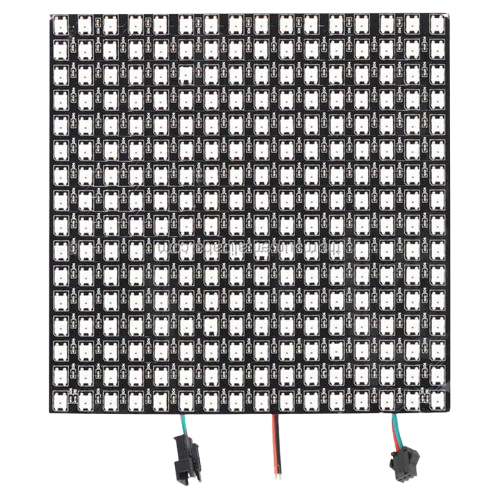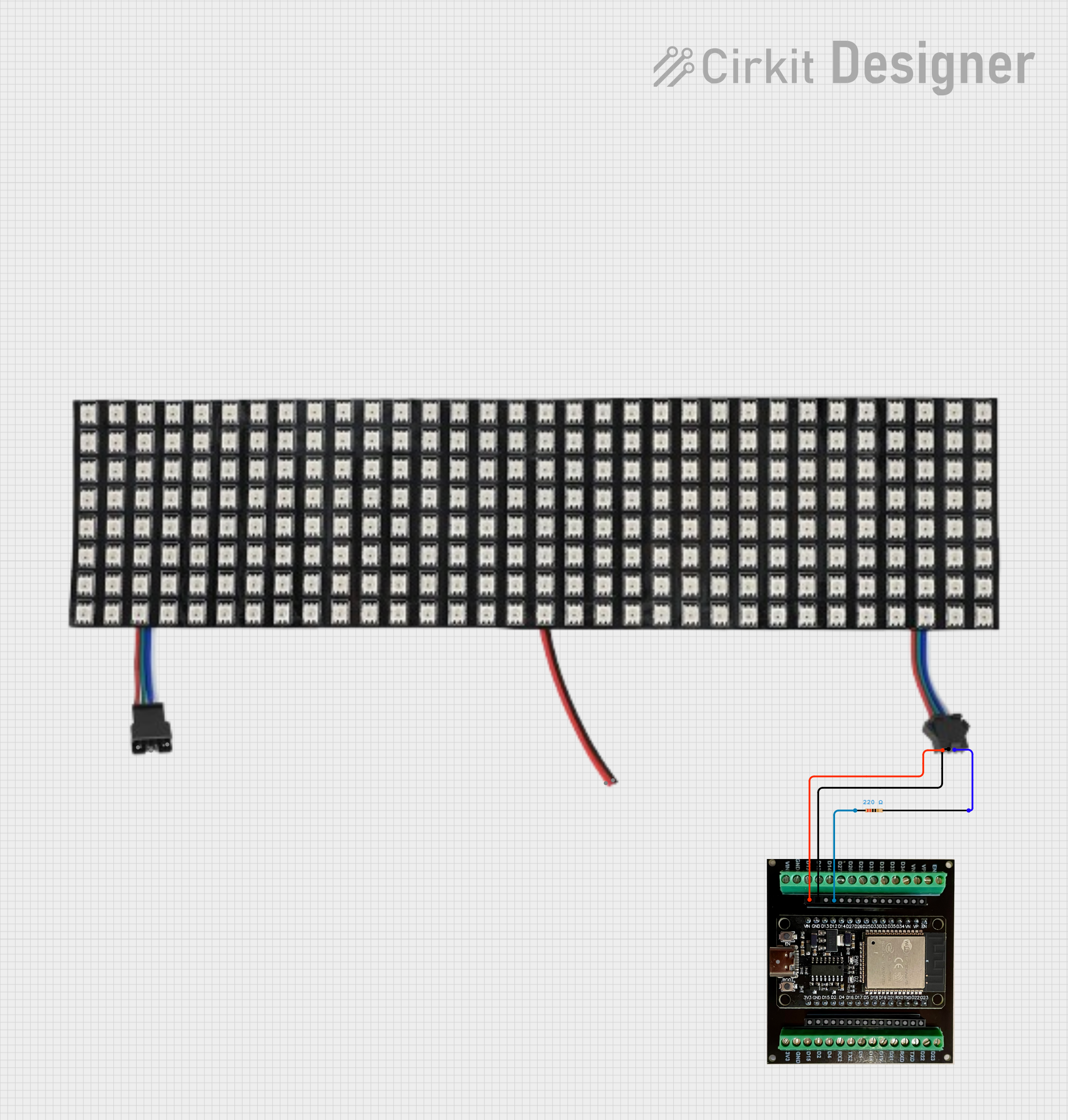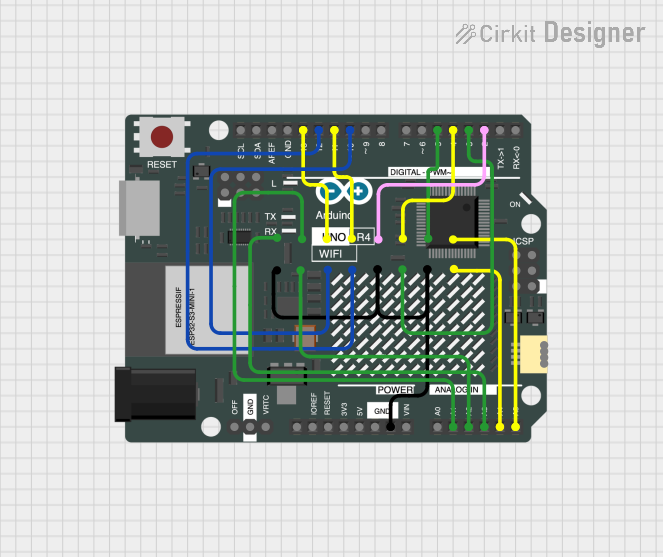
How to Use WS2812b RGB Matrix 16x16 (256 LED): Examples, Pinouts, and Specs

 Design with WS2812b RGB Matrix 16x16 (256 LED) in Cirkit Designer
Design with WS2812b RGB Matrix 16x16 (256 LED) in Cirkit DesignerIntroduction
The WS2812B RGB Matrix 16x16 (Manufacturer Part ID: WS2812B-16x16-Matrix) is a high-performance LED matrix manufactured by Worldsemi. It consists of 256 individually addressable RGB LEDs arranged in a 16x16 grid. Each LED is capable of displaying 24-bit color, allowing for vibrant and dynamic lighting effects. The matrix is controlled via a single data line, making it easy to integrate into various projects.
Explore Projects Built with WS2812b RGB Matrix 16x16 (256 LED)

 Open Project in Cirkit Designer
Open Project in Cirkit Designer
 Open Project in Cirkit Designer
Open Project in Cirkit Designer
 Open Project in Cirkit Designer
Open Project in Cirkit Designer
 Open Project in Cirkit Designer
Open Project in Cirkit DesignerExplore Projects Built with WS2812b RGB Matrix 16x16 (256 LED)

 Open Project in Cirkit Designer
Open Project in Cirkit Designer
 Open Project in Cirkit Designer
Open Project in Cirkit Designer
 Open Project in Cirkit Designer
Open Project in Cirkit Designer
 Open Project in Cirkit Designer
Open Project in Cirkit DesignerCommon Applications and Use Cases
- LED displays for text, animations, and images
- Decorative lighting and signage
- Interactive art installations
- Gaming setups and ambient lighting
- Educational projects and prototyping
Technical Specifications
Below are the key technical details for the WS2812B RGB Matrix 16x16:
| Parameter | Value |
|---|---|
| Manufacturer | Worldsemi |
| Part ID | WS2812B-16x16-Matrix |
| LED Count | 256 (16x16 grid) |
| LED Type | WS2812B (RGB, individually addressable) |
| Input Voltage | 5V DC |
| Power Consumption | ~60mA per LED (max brightness, white) |
| Communication Protocol | Single-wire (based on NRZ) |
| Data Input Pin | DIN (Data In) |
| Data Output Pin | DOUT (Data Out) |
| Refresh Rate | Up to 400 Hz |
| Operating Temperature | -25°C to +80°C |
| Dimensions | 160mm x 160mm |
Pin Configuration and Descriptions
The WS2812B RGB Matrix 16x16 has three main pins for operation:
| Pin Name | Description | Notes |
|---|---|---|
| VCC | Power supply input (5V DC) | Connect to a stable 5V power source |
| GND | Ground | Common ground for power and data |
| DIN | Data input | Connect to the microcontroller's data output pin |
| DOUT | Data output (optional) | Used to daisy-chain multiple matrices |
Usage Instructions
How to Use the Component in a Circuit
- Power Supply: Connect the VCC pin to a 5V DC power source and the GND pin to ground. Ensure the power supply can handle the current requirements of the matrix (up to ~15A at full brightness).
- Data Line: Connect the DIN pin to the data output pin of your microcontroller (e.g., Arduino, Raspberry Pi). Use a 330Ω resistor in series with the data line to protect the LEDs.
- Capacitor: Place a 1000µF capacitor across the VCC and GND pins to stabilize the power supply.
- Daisy-Chaining: If using multiple matrices, connect the DOUT pin of the first matrix to the DIN pin of the next.
Important Considerations and Best Practices
- Power Management: Avoid running all LEDs at full brightness to prevent overheating and excessive power draw.
- Signal Integrity: Use a short and shielded data line to minimize signal degradation. For longer distances, consider using a level shifter to ensure a 5V data signal.
- Heat Dissipation: Ensure proper ventilation or heat sinking if the matrix is used at high brightness for extended periods.
- Library Support: Use libraries like Adafruit NeoPixel or FastLED for easy control of the matrix.
Example Code for Arduino UNO
Below is an example of how to control the WS2812B RGB Matrix 16x16 using the Adafruit NeoPixel library:
#include <Adafruit_NeoPixel.h>
// Define the number of LEDs in the matrix
#define NUM_LEDS 256
// Define the pin connected to the DIN pin of the matrix
#define DATA_PIN 6
// Create a NeoPixel object
Adafruit_NeoPixel matrix = Adafruit_NeoPixel(NUM_LEDS, DATA_PIN, NEO_GRB + NEO_KHZ800);
void setup() {
matrix.begin(); // Initialize the NeoPixel library
matrix.show(); // Turn off all LEDs initially
}
void loop() {
// Example: Light up the matrix with a rainbow effect
rainbowCycle(10); // Call the rainbowCycle function with a delay of 10ms
}
// Function to create a rainbow effect across the matrix
void rainbowCycle(uint8_t wait) {
uint16_t i, j;
for (j = 0; j < 256; j++) { // Cycle through all colors
for (i = 0; i < matrix.numPixels(); i++) {
// Calculate the color for each LED
matrix.setPixelColor(i, Wheel((i + j) & 255));
}
matrix.show(); // Update the matrix with new colors
delay(wait); // Wait before the next update
}
}
// Helper function to generate rainbow colors
uint32_t Wheel(byte WheelPos) {
WheelPos = 255 - WheelPos;
if (WheelPos < 85) {
return matrix.Color(255 - WheelPos * 3, 0, WheelPos * 3);
} else if (WheelPos < 170) {
WheelPos -= 85;
return matrix.Color(0, WheelPos * 3, 255 - WheelPos * 3);
} else {
WheelPos -= 170;
return matrix.Color(WheelPos * 3, 255 - WheelPos * 3, 0);
}
}
Troubleshooting and FAQs
Common Issues and Solutions
No LEDs Lighting Up:
- Ensure the power supply is connected and providing 5V.
- Verify the data line connection and check for loose wires.
- Confirm that the microcontroller pin defined in the code matches the physical connection.
Flickering or Incorrect Colors:
- Add a 330Ω resistor in series with the data line to improve signal quality.
- Use a 1000µF capacitor across VCC and GND to stabilize the power supply.
- Check for proper grounding between the matrix and the microcontroller.
Matrix Not Responding to Code:
- Ensure the correct library (e.g., Adafruit NeoPixel) is installed and included in the code.
- Verify that the data pin in the code matches the physical connection.
- Check the microcontroller's output voltage; it should be 5V for proper operation.
FAQs
Q: Can I cut the matrix into smaller sections?
A: Yes, the matrix can be cut along the designated lines, but you must ensure proper reconnection of power and data lines for the remaining sections.
Q: How do I daisy-chain multiple matrices?
A: Connect the DOUT pin of the first matrix to the DIN pin of the next. Update the NUM_LEDS value in your code to reflect the total number of LEDs.
Q: What is the maximum distance for the data line?
A: For reliable operation, keep the data line under 1 meter. Use a level shifter or buffer for longer distances.
Q: Can I power the matrix directly from the Arduino?
A: No, the Arduino cannot supply enough current. Use an external 5V power supply capable of handling the matrix's power requirements.